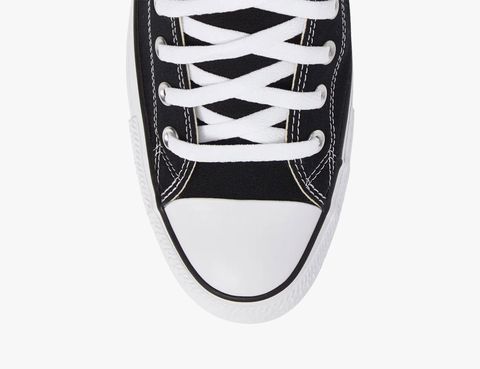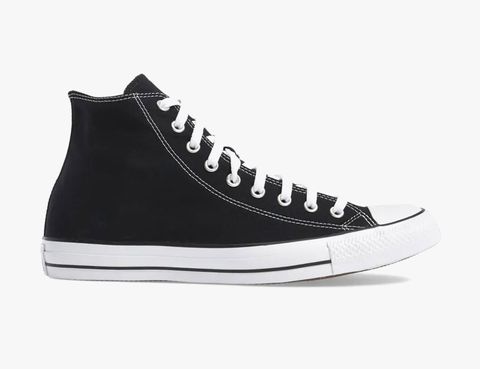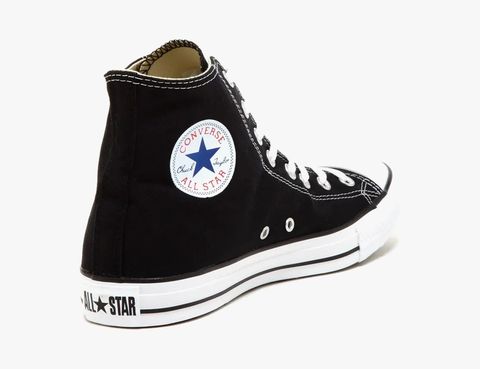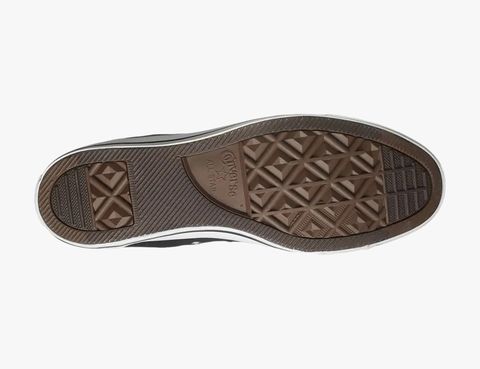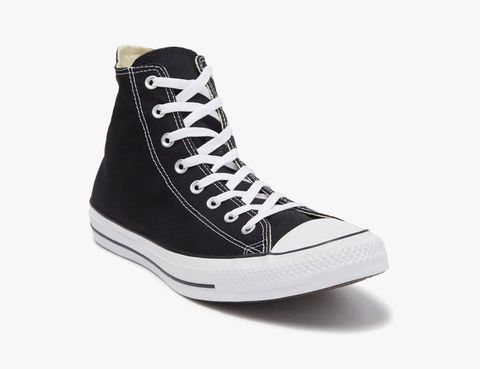Table of Contents
When it comes to footwear, there’s no mistaking the timeless profile of a Converse Chuck Taylor. Whether cut high or low, that canvas upper and oddly fuzzy sole is as iconic and recognizable as a Levi’s back pocket or Ralph Lauren polo player. But over the years — and through countless technological advancements in footwear — Chuck Taylors have moved beyond the basketball shoe beginnings, trading in sweat and athleticism for style and aesthetics.
Yet, while this staple in any closet might not be ruling the hardwood anymore — or like it once did, at least — don’t think Chuck’s lost his sporting step. Yes, those canvas, flat-soled sneakers can feel just as comfortable in the gym — and there’s plenty that swear by them.
But why would anyone want to train in Converse, a shoe that hasn’t changed in nearly 100 years? Why — when there are countless, more advanced footwear options for the gym — would so many competitive lifters step to the podium laced up in Chucks? We spoke to Todd Hamer, general manager at Union Fitness and former Division 1 strength and conditioning coach, to find out why this simple sneaker still has its feet firmly planted in gyms everywhere.
Keeping It Simple
The specs on today’s running and training shoes could almost read like a car manual. Technical foams, breathable uppers and carbon plates have been introduced to make working out comfortable and successful. While we’re not chastising these upgrades and appreciate the comfort of today’s kicks, when you’re lifting weights — specifically bench press, squats and deadlifts — the more cushion and tech could work against you.
To help you push off the floor rather than your shoe’s cushioning, you want footwear that has minimal to no added foam, along with a flat, stable base. The slim, no-cushion sole of Converse puts you closer to the ground, so when you push through your heel in, say, a squat or deadlift, your energy is more efficiently used to move the weight rather than losing juice fighting through the layers of cushioning. The flat sole also puts more of your foot in contact with the ground for a wider “platform” for improved stability.
Additionally, the canvas upper of Chuck Taylors create an appealing support system in two fashions. For one, specifically in high-tops, the canvas covers the ankle for just enough support and stability. Secondly, canvas is pliable, which can help you get a more comfortable footing under a squat. “I think it’s good that you can move your foot within the shoe,” says Hamer. “When you get under a heavy load, the foot will tend to flatten out.”
Playing the Mental Game
There’s also a psychological aspect to training in Chuck Taylors that can help you get into the right mindset for your next big lift. Because of their status as less of an athletic sneaker, putting on Chucks could be a helpful trigger to zone in and get yourself mentally ready for the weights, according to Hamer.
“I always go back to ‘Over the Top’ with [Sylvester] Stallone and he says, ‘What I do is I just try to take my hat and I turn it around, and it’s like a switch that goes on. And when the switch goes on, I feel like another person, I feel, I don’t know, I feel like a… like a truck.’”
80s nostalgia aside, there is merit to this quote. Hamer notes that having a change — a switch — to help your mind get ready for training can help you zone in on making the lifts. Utilizing this mental tool could be the key to getting you a new PR or overcoming a sticking point. And when you put those flat-soled sneakers on, you get that “Go time,” boost, says Hamer. “Put that Chuck on, you know, when you put it on your foot, you’re ready to train.”
A Cost-Effective Colossus
Converse has been a fashion mainstay not solely because of the iconic design. These kicks are relatively cheap, too, especially when compared to other footwear options. The lower entry cost and wide availability can mean athletes looking to improve their gym kicks can easily find a pair of Chuck Taylors for their needs, as opposed to more limited, more expensive training or lifting-specific footwear.
It should also be noted that not every training shoe transcends style the way Chuck Taylors can. Yes, the more technical shoes can be prime for the gym, but might look out of place strolling through town or paired with a pair of chinos. With Converse, there’s no questioning the style choice, so you can comfortably wear them out and about as well as during your training session. Even if you find that you don’t enjoy working out in Chucks, you’re still capable of adding them to your daily wardrobe. No harm, no foul.
Different Shoes for Different Needs
If this is your first time thinking of Converse Chuck Taylors as a gym shoe, don’t fret. After all, advancements happen to make our lives easier, and while Chucks can be great for strength training and promoting a more barefoot feel, there’s a reason they’re not the only shoe out there. “Yes, the human body is meant to be barefoot,” Hamer says, “It’s also not meant to do cleans, walk on asphalt and have broken glass around it. Shoes are good for a reason, and different shoes are good for different purposes.”
Some common examples where Chucks might not be the best for gym-goers would be anything related to agility training. The flat soles can provide a sturdy base during static lifts, but could quickly become uncomfortable if you add any running or agility aspect to your fitness routine. You wouldn’t run in a pair of flip flops, after all, right?
Even if you’re solely focused on strength training, there are movements that could be enhanced if your heel position is raised. For example, Hamer notes that over time, he has adopted Olympic lifting shoes for front squats. With a raised heel and closer stance, Olympic shoes can help promote a comfortable knee plane for a more natural squat. This change in footwear, Hamer states, was a response to his body changing over time, which is a notion he values greatly and promotes to others when choosing fitness equipment.
“I think that’s something people have to appreciate, too. As you age, as you grow, as you change as a lifter, as a human, the shoe you wear may change because you’re physically a different person, and you’re going to have different tightnesses, different strengths, different weaknesses,” Hamer says.
Above all, comfort is the name of the game when choosing fitness footwear. There’s no sense in trudging through a workout if your kicks are going to make it miserable. But, if you do have an itch to strengthen up your gym sneakers, don’t rule out the iconic silhouette that is a Chuck Taylor.
This content is created and maintained by a third party, and imported onto this page to help users provide their email addresses. You may be able to find more information about this and similar content at piano.io
 fashion rec fashion wanted
fashion rec fashion wanted

